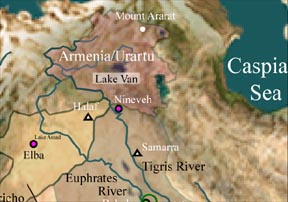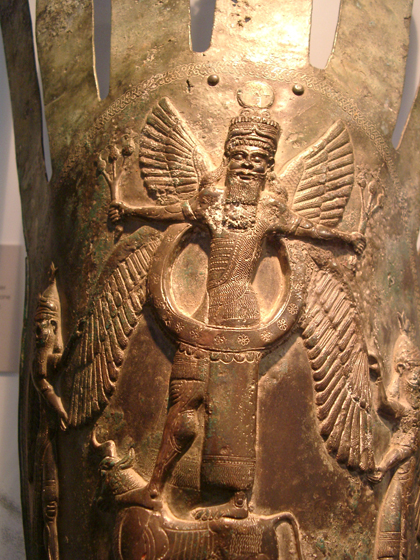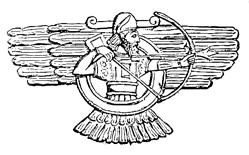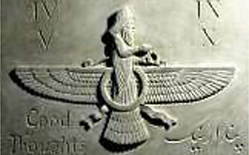 The Steadfast | |||
| Hero of the Rebellion If one had to pick the most valiant person in our planet's history it would have to be Van. Even today if you look at a map of present day Turkey you will see Lake Van. Its ancient name immortalizes Van the steadfast. The kingdom of Urartu translates as “the kingdom of Van”. It is one of the possible locations where the Tree of Life was guarded for millenniums waiting for the arrival of Adam and Eve. At the outbreak of the rebellion Van and his followers removed the Tree of Life from southern Mesopotamia and transplanted it to somewhere in the mountains of Afghanistan. Later the Tree of Life would be transplanted in an area of the eastern part of the Kopet Dagh. This location would become the easternmost boundary for the later appearing Kingdom of Van. It was Van who enlisted and organized the local inhabitants to help with the creation of the Garden of Eden. He stood up against Lucifer, Satan and Caligastia - huge celestial personalities - and defended the divine plan that was to advance the culture of earth. He and his human associate, Amadon, are the genii depicted with the Tree of Life so familiar across Mesopotamia. Van as Enki the Serpent Van may be found in ancient Sumerian texts as the god Enki as represented as the serpent of Akkadian Ea: "Professor Kramer on Enki's fruit tree garden at Eridu, note that Enki (Ea) is described as a WALKING, TALKING, GREAT USHUMGAL "_SEPENT/DRAGON_," WHO IS _CUNNING AND WISE_ AND ASSOCIATED WITH PLANTING A GARDEN OF FRUIT-TREES AT ERIDU WHERE LIVES ADAPA. Eden's serpent could walk and talk and was associated with a garden full of fruit trees planted on the earth by _a_ god (Yahweh) and the serpent (the New Testament's "serpent/dragon") famed for his "cunning" and "wisdom" (cf. Matthew 10:16 "...be ye therefore WISE AS A SERPENT..."). Perhaps the mes-tree planted by the CUNNING and WISE GREAT USHUMGAL has been transformed by the Hebrews into the "Tree of Knowledge of Good and Evil"? "Lord who walks nobly on heaven and earth, self-reliant, father Enki, engendered by a bull, begotten by a wild bull...king, who turned out the mes-tree in the Abzu, raised it up over all the lands, GREAT USHUMGAL, who planted it in Eridu- its shade spreading over heaven and earth- A GROVE OF FRUIT TREES stretching over the land... Enki...lord of wisdom...you have given the people a place to live...you have looked after them... Enki, king of the Abzu, celebrates his own magnificance as is right... I AM CUNNING AND WISE IN THE LANDS... I am lord, I am the one whose word endures. I am eternal..." (pp. 39-41. "Enki and Inanna: The Organization of the Earth and Its Cultural Processes." Samuel Noah Kramer and John Maier. Myths of Enki, the Crafty God. New York & Oxford. Oxford University Press. 1989) Note: Another hymn speaks of the mes-tree as being "the flesh of the gods." Perhaps what is meant is that at times statues of the gods were carved from its wood ? If so, then to the degree that gods were understood to be "immortal" the mes-tree would be associated with "immortality"? That is to say the mes-tree might be what is behind Eden's "Tree of Life" which confers immortality on human flesh ? The above hymn's mention of a "grove of fruit trees" planted by Ea the Ushumgal at Eridu, may be the source of Genesis' notion that Adam and Eve have access to fruits from trees planted by God in his garden before their creation." (http://www.homestead.com/bibleorigins*net/AdapaAdam.html) This was the first definite connection I had seen between Van and Enki. Although I have long suspected that it was so. One reason is that Enki favored mankind, Enlil did not. Enki and Enlil in the Sumerian pantheon are half brothers. The UB does not state whether or not Van and Nod were brothers. Probably not, but perhaps they are archetypes. It could mean that they represent the split at the time of the rebellion. For one thing they probably did not particularly like one another. That's understandable being on opposite sides of the rebellion. The different mothers theme may represent the "family split". Enlil was the elder son with Enki his junior. In Sumerian mythology (according to one myth) Ki was Enlil's mother and Antu was Enki's mother. Both mothers were the sisters of Anu. However, Antu was the senior sister and there's the rub. Does kingship flow through the matrilineal or the paternal? Very clever, for stories written five thousand years ago. This was written during the Neolithic - the time that has been deemed as the overthrow of the earth goddess and the rise of the patriarchal warrior tribes. Anu the father with Enlil and Enki comprise the top three gods of the Sumerian pantheon. Enlil is considered above Enki in rank. The Andites worshipped the mother goddess. "Enki is regularly given the epithet "LORD OF WISDOM"...we have chosen to avoid "wisdom" when the Enki stories seem to demand shrewdness and cunning, the arts of the trickster. Enki astonishes even the other gods with shocking solutions to apparently impossible problems...Perhaps "crafty" is the better term to use for the problem-solving Enki...In particular, Enki is the father who imparts knowledge to his son. Enki was, perhaps more than any other ancient deity, essentially identified with the spoken and the written word." (p. 5. "Introduction."Samuel Noah Kramer and John Maier. Myths of Enki, the Crafty God. New York & Oxford. Oxford University Press. 1989)" Van as Enki the god • Enki possessed the secret of the me, the divine laws, leading humanity towards knowledge.It was Van who was the keeper of the divine law. Only Van had that authority as he was the titular head of the planet. The me (pronounced may) were the evidence of art, culture and learning. Through these decrees is civilization imparted to the world. • Enki was associated with plants and trees, in particular the mes-tree (he planted a mes-tree in Inanna's garden)Van was the only one allowed to protect the Tree of Life. At the time of the Lucifer Rebellion he and his followers took the tree with them and eventually replanted it in the probable vicinity of the Kopet Dagh. Immortality was granted to Van and his followers by being able to process the energy from the fruit of the Tree of Life. This is the main reason the iconology of the Tree of Life was so strong throughout this region and later influencing the Sumerians, Akkadians, Assyrians and Babylonians. In the myth of Inanna and the Huluppu Tree: "... At that time, it was planted, a tree, a single tree, by the banks of the Great River, Enki, the Father, did plant the Huluppu-tree, The God of Wisdom, he planted it by the banks of the Euphrates, Before he set sail, before the Father departed for the underworld. ...The whirling South Wind arose and blew upon the tree, Pulling at its roots and ripping at its branches, Until the waters of the Euphrates carried it away. A young woman who walked in fear of no man, and would not be owned, Plucked the tree from the river and spoke: "I shall bring this tree to Uruk. I shall plant this tree in my holy garden."" From the quotes above Enki plants a tree on the banks of the Euphrates river. The tree is uprooted and transplanted in Innana's "holy garden". When the Caligastia 100 first arrived in the land that was to become Mesopotamia, the Tree of Life was planted to provide the energy of immortality for the 100. At the outbreak of the rebellion Van "uprooted" the tree and carried it eventually to the northern mountains were it would be much later transplanted into the Garden of Eden. • Enki was tricked by Innana into giving her the me Van when he met with Adam and Eve did in fact hand over the "me". He relinquished his titular authority to the new world rulers. Technically, it was the Melchizedeks who formally installed Adam and Eve. This event was recorded in the Sumerian myth of Inanna and the God of Wisdom: "... Enki and Inanna drank beer together. They drank more beer together. They drank more and more beer together. With their bronze vessels filled to overflowing, With the vessels of Urash, Mother of the Earth, They toasted each other; they challenged each other. Enki, swaying with drink, toasted Inanna: "In the name of my power! In the name of my holy shrine! To my daughter Inanna I shall give The high priesthood! Godship! The noble, enduring crown! The throne of kingship!" Inanna replied: "I take them!" This continues until a drunken Enki gives all the mes to Inanna. Then Innana takes the mes to Uruk in her Boat of Heaven. After Enki realizes what has happened he tries in vain to recall the mes. The last lines has Enki graciously giving Innana the mes: "Then Enki spoke to Inanna, saying: "In the name of my power! In the name of my holy shrine! Let the me you have take with you remain in the holy shrine of your city. Let the high priest spend his days at the holy shrine in song. Let the citizend of your city prosper. Let the children of Uruk rejoice. The people of Uruk are allies of the people of Eridu. Let the city of Uruk be restored to its great place."" • Enki was considered a benevolent godIt is quite evident that Van was a benevolent leader. The Nodites were known for their belligerent behavior. After all they spilt further into three smaller groups after falling into quarrelling with one another. • Enki saved humanity from the floodAlthough Van had nothing to do with saving humanity from a flood the sentiment is appropriate. • Enki in one of the myths creates the first humansI think this myth of Enki creating the first humans is because of the relationship he had with Adam and Eve. Van was well aware of who they were at the time of their arrival. He enlisted the help of members of tribes he associated with to help construct the Garden of Eden and replanted the Tree of Life. So this myth of Enki creating the first humans makes sense as well as his association with the mes-tree (sacred tree). I also think that because of the Vanite's relationship with the Syrian Nodites the story of Adam and Eve as remembered by the Hebrews and their forefathers is a more "pure" version of what happened. Although that information could have been imparted by Machiventa Melchizedek the Priest King of Salem. • The Roman name for Enki is VulcanIt is interesting that the Roman Vulcan is Enki. It was in the region around Lake Van that metallurgy may have first began. Exactly where the birth of metal happened is unknown but Anatolia is very high on the list. • Enki's holy number is 40 (as Ea - Babylonian) This is truly odd. The number of the faithful was fourty, the number of the rebels is sixty which is Anu's holy number. Anu is of course the head god of the Annunaki - the Watchers - the fallen. • Enki was associated with the written word Fad under Van was the teacher of the written word. And as it becomes more apparent it is in this region about Lake Van that the first glimmer of writing is found. There are other locations that also claim having the first writings. True writing came into existence long after the departure of Van. • Enki had an assistant named Isimud his minister, vizier and friend. Isimud is represented with two faces just as Janus is today. Van also had an assistant named Amadon who was a modified human. Both Van and Amadon were sustained by the Tree of Life. Amadon was of two natures, the divine and human. The Assyrians were the direct descendants of the Vanites and consequently perpetuated the veneration of the legend of the Tree of Life. In fact, the area that the Vanites inhabited was adjacent to or overlapped the kingdom of Assyria in the Paleolithic. The capital of Assyria, Ninevah was next to the boundaries of Urartu from which Armenia emerged. Also living close by to the west were the Syrian Nodites who also were in the lineage of the Assyrians. And as it has been shown, the tree's power of persistence was carried out to the world at large. Van and the Indus Valley Van with the rest of the loyalists settled originally in the highlands west of India known as Afghanistan and just west of what would become to be known as the Indus Valley. Sometimes this area is refered to as the Punjab. Outposts of the Indus Valley civilization reached as far north as the Oxus River in Afghanistan. This civilization sometimes called Harappan (about 3200–2600 BC for pre Harappan, c. 2600-1900 B.C. for the Harappan civilization) rivals Sumer and Egypt as the oldest. The civilization of the Indus Valley was ruled by commerce and religion - not by military strength. There is no evidence of the ritual fire altars as found with Mesopotamian civilizations neither can any public building yet found be determined as a temple. Religious practices are implied mainly from figurines such as assumed female goddesses and the bull horned male figures. The Harappans did bury their dead with provisions for the afterlife. The Pipal tree was used as a religious symbol (later known as the Bodhi tree under which the Buddha gained enlightenment). As of yet the written language of this civilization has not been deciphered. This civilization is called Harappan but the political center seems to have been at Mohenjo-Daro, Harappa's sister city to the south. The Aryan invaders disrupted much of the agricultural advancements and of the later Harappan culture and may have led to its ultimate decline along with deforestation with other natural distasters. There is growing evidence that it was in the mountains and plateaus north of Sumer that the earliest achievements of the now emerging Sumerians began. The area around Lake Van is rich in volcanic minerals which would be converted into metal implements of art and war. As mentioned before the first of the Sumerian writings have been discovered in this region. The start of agriculture also had its roots in eastern Anatolia.  
The above image from Urartu, the kingdom of Van, shows a figure of divinity atop a bull. He wears the horned cap of divinity, has the wings of divinity, a pattern of rosettes the symbol of the Tree of Life surrounds him, holds the 3 segmented fruit from the Tree of Life and on top of his cap is a representation of the winged disk. Each of the fruits is debossed with a rosette. This is the ultimate image of divinity. There is only one person who could be surrounded by these icons and that is Van.One of the most interesting features of this metal relief is the rim which the figure stands within. Notice how the wings are attached to the rim rather than directly to the figure. This same arrangement is how the winged disk is represented. The Assyrians sometime show Ashur their national god in much the same way. The circular rim with attached wings is a representation of the solar disk or sometimes called the winged disk.
|
Σύμπαν και άνθρωπος
Όλα στο σύμπαν αφορούν τη μεταμόρφωση.Η ζωή μας μοιάζει με τις σκέψεις που τη διαμορφώνουν.
Μάρκος Αυρήλιος
Μάρκος Αυρήλιος
Κυριακή 21 Απριλίου 2013
Van-Enki
Εγγραφή σε:
Σχόλια ανάρτησης (Atom)


Δεν υπάρχουν σχόλια:
Δημοσίευση σχολίου